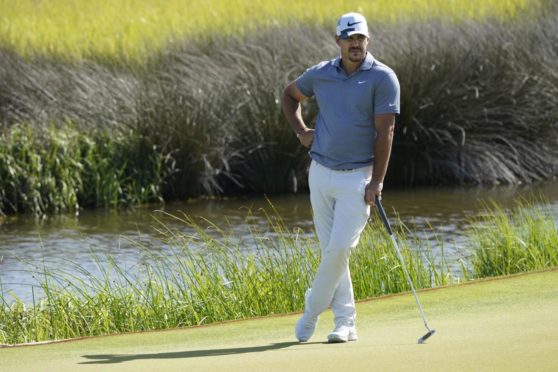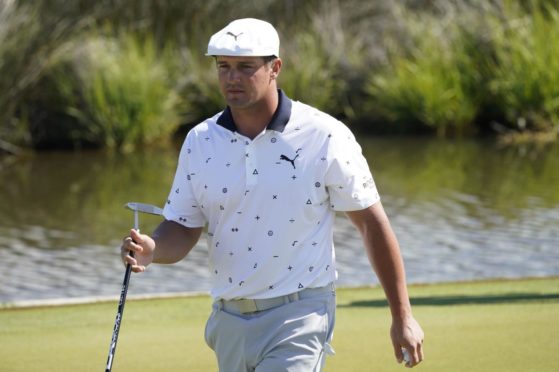In considering the “feud” of Brooks Koepka and Bryson DeChambeau that has caused some degree of pearl-rattling in golf this past week, let’s consult those old reliables Oscar Wilde and PT Barnum.
The great American showman is reputed to have said “I don’t care what anyone says about me, so long as they’re speaking about me”. Oscar, around the same time, chipped in with “there is only one thing worse than being talked about, and that is not being talked about”.
The video that went viral on Twitter in the wake of the PGA Championship reached the parts of Media Universe that tiny little Golf World rarely sees. The antipathy between the two aspirant Alpha Males of the sport has genuinely engaged the wider sporting public.
How anyone can think this is a bad thing is frankly way beyond my limited ken.
‘I honestly wouldn’t even care’
The Brooks-Bryson rivalry had seemingly died down over the last year, that is until Koepka eye-rolled DeChambeau into oblivion in this video from the PGA Championship 😳: https://t.co/h0AWGzr45y pic.twitter.com/98qHKfqsmM
— Golf Digest (@GolfDigest) May 25, 2021
A quick reprise: the video concerned is a TV interview outtake featuring Koepka’s obvious – and colourfully verbal – exasperation with DeChambeau’s passing presence in the wake of the final round at Kiawah.
The video found its way from the editing suite to delighted public consumption via social media. This angered a good many people of a delicate constitution, it appears.
Seriously, when interviewer Todd Lewis says how much his editors will love the outtake, Koepka replies “I honestly wouldn’t even care”.
Some sleuthing by Dylan Dethier of Golf.com has “multiple sources” saying that Koepka actually requested a copy of the clip to send to his friends for a laugh. Although he didn’t intend for it to get out there to such a degree, he was entirely sanguine about it.
The barbs that followed from Brooks and Bryson on social media in the aftermath suggested both were fine about it being made public. Any outrage here is laughably misplaced.
Some ultra-cynics – yea, even more so than your correspondent – suggested it was all a put-up job. It gave the pair a head start in the PGA Tour’s Player Impact Program money which rewards social media engagement.
Guys, come on. Not everything is a conspiracy.
More feuds needed the too-cosy world of golf
Leaked video of Brooks Koepka, Bryson DeChambeau reveals their personal feud is very much alive https://t.co/bmYchUHLgC
— Golfweek (@golfweek) May 25, 2021
Anyway, who is up for some full-on public antipathy among the stars of the otherwise too-cosy world of golf? We should be, because it moves the needle much more than Bryson’s recent video with his shirt mysteriously missing for no good reason.
We should be welcoming some colour in golf. God knows there are enough colourless people playing it at the top level.
The two adversaries in this feud are a good case in point. Brooks is pretty good in the interview arena, usually frank – to the point of offending some – but always honest.
Bryson’s method is quite different with his whacky scientific tangents and regularly dubious use of the English language. “Conversated” last week was a prize example. But he’s usually great value.
What do we really want? We could have Rickie Fowler, who in my experience has never said anything remotely interesting in an interview situation. Or Dustin Johnson, who apart from some homespun philosophy on occasion, is a dreadful interview.
As for whose side are you on (Team Brooks all day, if I’m forced) who really cares?
A sanitised version of sport by the entitled elite
Statement from Grand Slam tournaments regarding Naomi Osaka.#RolandGarros
— Roland-Garros (@rolandgarros) May 30, 2021
Last week Naomi Osaka, the women’s world No 1 at tennis, announced her intention not to engage in media activity at the French Open.
Osaka has not had a remotely rough ride from the media in her rise to the top. She admitted herself to having “good relationships” with some members of the press throughout her career. (Tune into the next live Roger Federer or Novak Dojkovic interview session if you think the tennis scribes are a particularly hard school.)
Osaka made mention of mental health, and clarified it further when she withdrew from the tournament – which is probably what she should have done at the outset. The impression remains – and indeed she sort of admitted – that she dropped media duties because they are inconvenient to her.
Roland-Garros and the other Grand Slams reacted by slapping a huge fine on her and even threatening expulsion. That’s great for us scribes (and I would contend for the sport-consuming public too). But the fact that Osaka feels powerful enough to make this stand is concerning.
If you want this `ain’t-they-just-wunnerful’ saccharine coverage of our major sports stars, then fine. You stick to the sanitised, artificial output that some post on their social media accounts.
DeChambeau already engages in this sort of thing with his relentless, strictly controlled self-promotion. But he was also willing to engage in this spat, suggesting he understands that everything’s not always sunshine and lollipops.
Even if it actually is all a construct, the feud is far more entertaining than anything Bryson’s put out on Instagram or Youtube.
This one should run and run. For the benefit of the game.
…and a proper test for Stricker’s Team USA
If this is all actually genuine an additional issue, of course, is that the pair will be Ryder Cup team-mates for Steve Stricker’s USA at Whistling Straits in September.
To me, that’s the ultimate test of whether Stricker can make the US a proper team. Antipathies amongst Europeans have been left at the team room door (and sometimes re-engaged on exit) in their successful era.
It’s part of what has made Europe so formidable. If the US can let any bygones be bygones, they might be a proper team at last.

